Motion NCERT Solutions Class 9
Table of Contents
Click here to download Motion NCERT Solutions Class 9 🖱️👉 Get solution pdf

Question 1:
An athlete completes one round of a circular track of diameter 200 m in 40 s. What will be the distance covered and the displacement at the end of 2 minutes 20 s?
Ans: Diameter of a circular track d = 200m
Time taken by athlete in complete one round of a circular track t = 40 s
Radius of a circular track r = d/2 = 200/2 = 100 m
Distance covered by athlete in one round of a circular track x = circumference of circular track = 2πr = 2 × 3.14 × 100 = 628 m
Speed = distance covered / time taken = 628 / 40 = 15.7 m/s
Total time taken = 2 min 20 = 140s
Distance covered by athlete at the end of 2 minutes 20 s is ,
Distance = speed × total time taken = 15.7 m/s × 140s = 2198 m ≈ 2200 m
Displacement in 2 minutes (= 120s) will be zero because the athlete will complete 3 rounds (one round in 40s) and at that time the initial position and final position will be the same.
But, after the next 20s, the final position of the athlete will be equal to half of the circumference (one complete round in 40s), so the displacement will be equal to the diameter of the circular track, which is 200 m.
Question 2:
Joseph jogs from one end A to the other end B of a straight 300 m road in 2 minutes 30 seconds and then turns around and jogs 100 m back to point C in another 1 minute. What are Joseph’s average speeds and velocities in jogging (a) from A to B and (b) from A to C?
Ans:

(a) From point A to B
Distance covered by Joseph while jogging from A to B = 300 m
Displacement from A to B = 300m
Time taken = 2 min 30 seconds = 150 s
Average speed, vav = distance/ time taken
vav = 300/150 = 2m/s
Average velocity = displacement/ time taken= 300/150= 2m/s
So, the average speed and average velocity of Joseph from A to B are the same.
(b) From point A to C (after returning from point B)
Total distance covered = Distance from A to B + Distance from B to C = 300 + 100 = 400 m
Total time taken = Time taken to travel from A to B + Time taken to travel from B to C = 150s + 60s = 210 s
Average speed = total distance travelled/ time taken = 400/210 = 1.90 m/s
Displacement between point A and C = AC = AB − BC = 300 − 100 = 200 m
Time interval = time taken to travel from A to B + time taken to travel from B to C = 150 + 60 = 210 s
Average velocity = displacement/ time taken= 200/210 = 0.95 m/s
Question 3:
Abdul, while driving to school, computes the average speed for his trip to be 20 km/ h. On his return trip along the same route, there is less traffic and the average speed is 30 km/ h. What is the average speed for Abdul’s trip?
Ans: Let distance travelled by Abdul , between starting point and school is d.
Average speed of Abdul’s while driving to school = 20 km/h
Time taken to reach school = t1= distance/speed = d/ 20
Distance travelled by Abdul, while returning from school = d
Time taken = t2 = distance/speed = d/ 30
Total time taken= t1+t2= d/ 20 + d/ 30 = 5d/ 60
Total distance covered in the whole trip = d + d = 2d
Average Speed= total distance travelled/ total time taken= d+d / (t1+t2)= 2d/(5d/ 60) = 24 km/h
Question 4:
A motorboat starting from rest on a lake accelerates in a straight line at a constant rate of 3.0 m/s2 for 8.0 s. How far does the boat travel during this time?
Ans: GIVEN: Acceleration of the motorboat, a = 3 m/s2 Time taken, t = 8 s
Initial velocity of motorboat, u = 0 (since the motor boat is initially at rest)
How far does the boat travel = displacement of motorboat = x
From equation of motion second,
x= ut+ 1/2 at2
x= u×0 + 1/2 × 3 × (8)² = 96m
Ans: For car A:
Initial speed of the car (A) = 52 km/h × 5/18 = 14.4 m/s
From equation of motion 1st v = u + at
a = (v-u) / t = (0 – 14.44 ) / 5 = -2.89 m s–2
Putting these value in equation of motion 1st v = u + at
t =0 v = u + at = 14.4 + (-2.89) × 0 = 14.4 m/s
t =1 v = u + at = 14.4 + (-2.89) × 1 = 11.55 m/s
t =2 v = u + at = 14.4 + (-2.89) × 2 = 8.66 m/s
t =3 v = u + at = 14.4 + (-2.89) × 3 = 5.77 m/s
t =4 v = u + at = 14.4 + (-2.89) × 4 = 2.88 m/s
t =5 v = u + at = 14.4 + (-2.89) × 5 = 0 m/s
Using these value plot graph between speed-time for car B.
From graph: Distance covered by the first car (A) before coming to rest = Area of triangle AOB = ½ × AO × BO = ½ × 14.44 m/s × 5 s = 36.1 m
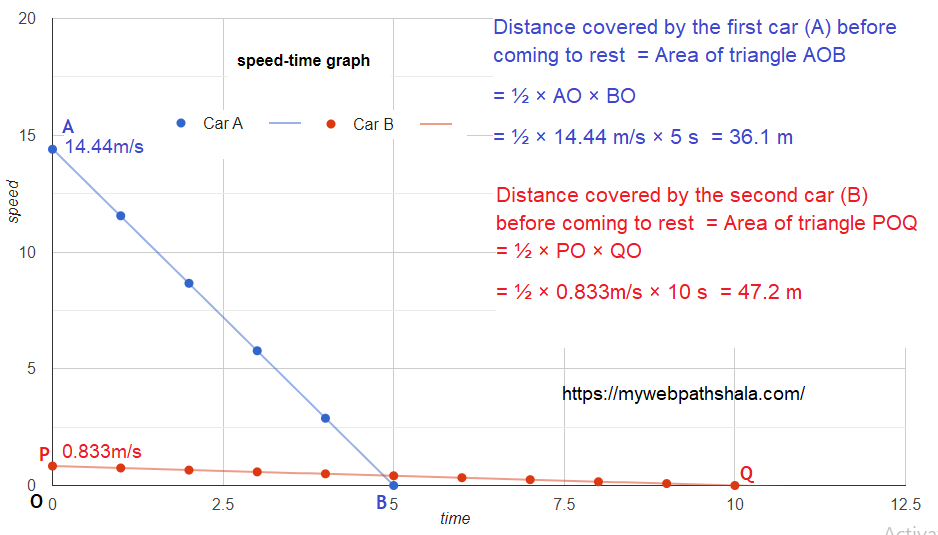
For car B:
Initial speed of the car (A) = 3 km/h × 5/18 = 0.833 m/s
From equation of motion 1st v = u + at
a = (v-u) / t = (0 – 0.833 ) / 10 = -0.083 m s–2
Putting these value in equation of motion 1st v = u + at
t =0 v = u + at = 0.833 + (-0.083) × 0 = 0.833 m/s
t =1 v = u + at = 0.833 + (-0.083) × 1 = 0.75 m/s
t =2 v = u + at = 0.833 + (-0.083) × 2 = 0.66 m/s
t =3 v = u + at = 0.833 + (-0.083) × 3 = 0.58 m/s
t =4 v = u + at = 0.833 + (-0.083) × 4 = 0.50 m/s
t =5 v = u + at = 0.833 + (-0.083) × 5 = 0.416 m/s
t =6 v = u + at = 0.833 + (-0.083) × 6 = 0.333 m/s
t =7 v = u + at = 0.833 + (-0.083) × 7 = 0.250 m/s
t =8 v = u + at = 0.833 + (-0.083) × 8 = 0.160 m/s
t =9 v = u + at = 0.833 + (-0.083) × 9 = 0.083 m/s
t =10 v = u + at = 0.833 + (-0.083) × 10 = 0 m/s
Using these value plot graph between speed-time for car B.
From graph: Distance covered by the second car (B) before coming to rest = Area of triangle POQ = ½ × PO × QO = ½ × 0.833m/s × 10 s = 47.2 m
Thus, the second car (B) travels farther than the first car (A) after they applied the brakes.
Fig 8.11 Shows the distance-time graph of three objects A, B and C. Study the graph and answer the following questions: (a) Which of the three is travelling the fastest? (b) Are all three ever at the same point on the road? (c) How far has C travelled when B passes A? (d)How far has B travelled by the time it passes C?
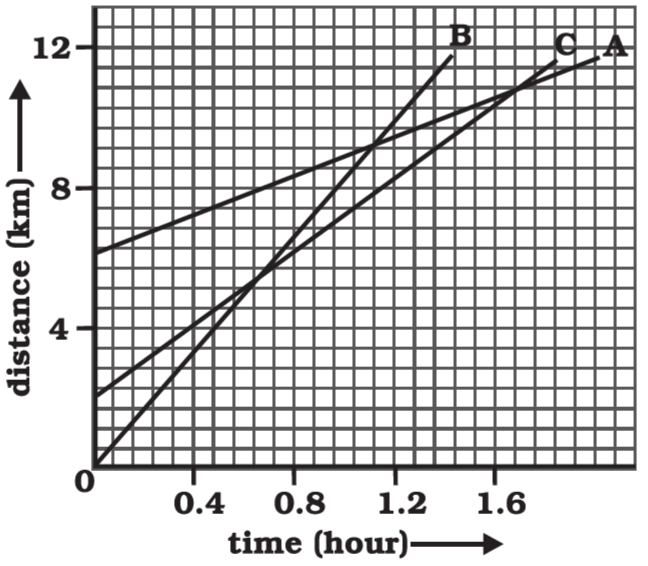
Ans: (a) Speed = Slope of distance-time graph.
Since Object B has more slope than A and C, that’s why speed of object B is greater than A and C.
(b) No. All three objects A, B and C never meet at a single point.
But, at (i) 1.6 second A and C are at the same point on the road.
(ii) 1.12 second A and B are at the same point on the road.
(III) 0.64 second B and C are at the same point on the road.
(c) There are 7 unit areas of the graph between 0 and 4 on the Y axis so, 1 graph unit equals 4/7 km. Since the initial point of an object C is 4 graph units away from the origin, Its initial distance from the origin is 4 × (4/7)km = 16/7 km
When B passes A, (at 1.12 second) the distance between the origin and C is 8km
Therefore, total distance travelled by C in this time = 8 – (16/7) km = 5.71 km
(d) B possesses C at time 0.64second. Distance covered by B at that time is equal to 5.143km (9 boxes/area units on Y-axis)
A ball is gently dropped from a height of 20 m. If its velocity increases uniformly at the rate of 10 m/ s2, with what velocity will it strike the ground? After what time will it strike the ground?
Ans: Distance covered by the ball = height from which ball is dropped x = 20 m
Acceleration, a = 10 m/s2
Initial velocity of ball, u = 0 (ball is initially at rest and ball is gently dropped not thrown)
Final velocity of the ball with which it strikes the ground, v =?
From equation of motion 2nd x = u t +1/2 at2
x= 20 = 0 × t +1/2 (10) t2
40 = (10) t2
t = 2s
Alternate method
From equation of motion 3rd v2 – u2 = 2 ax
v2 – (0)2 = 2 × 10 × 20
v2 = 400
v = 20 m/s
From equation of motion 1st v = u + at
20 = 0 + 10 × t
Time taken by the ball to strike the ground is, t = 2 s
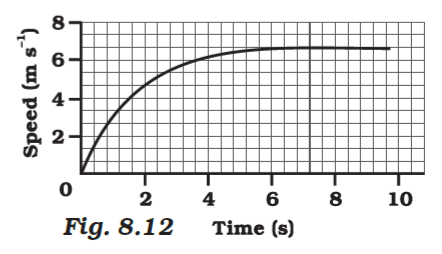
Ans: (a) Distance travelled by car in first 4 second = area of speed-time graph = 1/2 × 4 × 6 = 12m
The shaded area which is equal to represents the distance travelled by the car in the first 4 s.
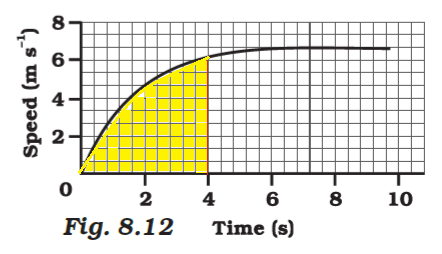
(b) The part of the graph in red colour between time 6 s to 10 s represents uniform motion of the car, as speed does not change in this duration.
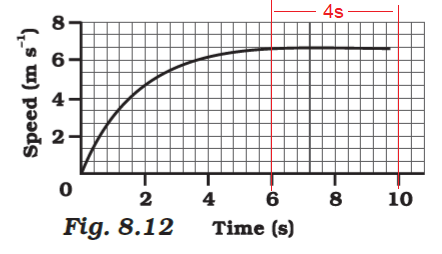
State which of the following situations are possible and give an example for each of these: (a) an object with a constant acceleration but with zero velocity. (b) an object moving in a certain direction with an acceleration in the perpendicular direction.
Ans: (a) It is possible that an object has constant acceleration but with zero velocity. When a ball is thrown upward, at its highest point, its velocity is zero, although it has constant acceleration equal to the acceleration due to gravity.
(b) It is possible that an object moving in a certain direction have acceleration in the perpendicular direction. For example: When a body moves on circular path, its acceleration is perpendicular to its direction of motion (velocity in tangential direction).
An artificial satellite is moving in a circular orbit of radius 42250 km. Calculate its speed if it takes 24 hours to revolve around the earth.
Ans: Speed = Distance travelled /Time taken = x /t
Distance x = 2πr = 2×3.14×42250 = 265330 km
Time t = 24 h Speed = x /t = 265330/ 24 = 11055.4 km/h
Motion Solutions Class 9 👆
MY YouTube Channel Link : 👉🖱 https://www.youtube.com/channel/UCGpC7nWE0-bBv9I53MM8qjQ
Motion NCERT Solutions Class 9, Motion Solutions Class 9, Motion NCERT Solutions Class 9, Motion Solutions Class 9, Motion NCERT Solutions Class 9, Motion Solutions Class 9, Motion NCERT Solutions Class 9, Motion Solutions Class 9, Motion NCERT Solutions Class 9, Motion Solutions Class 9, Motion NCERT Solutions Class 9, Motion Solutions Class 9, Motion NCERT Solutions Class 9, Motion Solutions Class 9, Motion NCERT Solutions Class 9, Motion Solutions Class 9, Motion NCERT Solutions Class 9, Motion Solutions Class 9, Motion NCERT Solutions Class 9, Motion Solutions Class 9, Motion NCERT Solutions Class 9, Motion Solutions Class 9